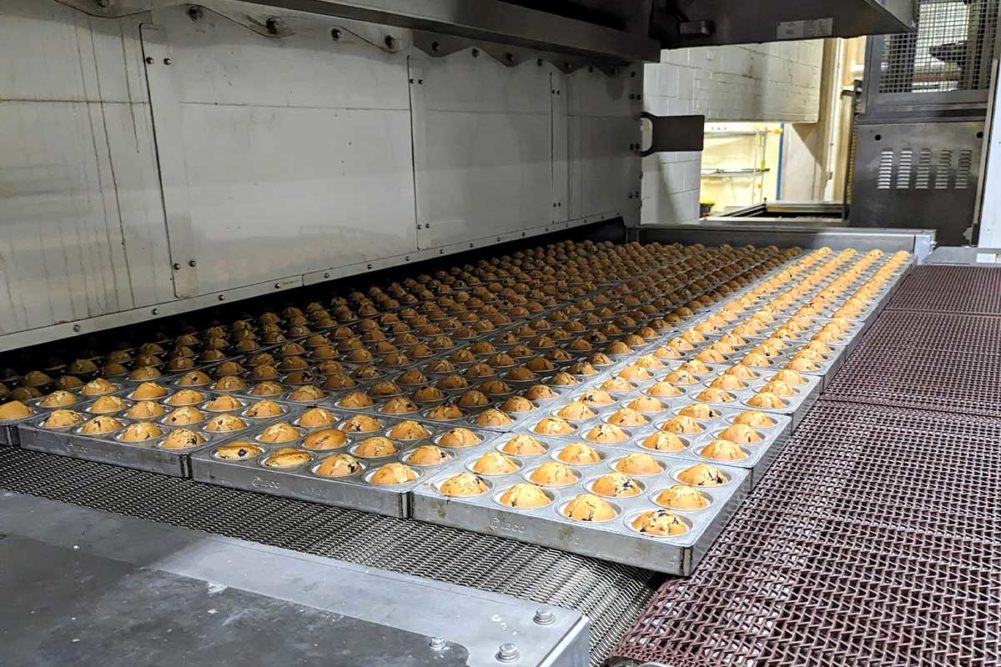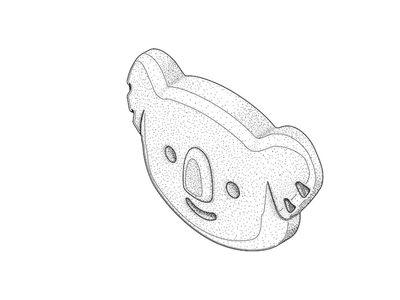Muffin Town has been ramping up production at its automated facility in Lawrence, Mass. The producer of sweet goods baked with a halo of health recently installed a new line for making crustless sunflower and jelly sandwiches. It also added more versatility to the bakery with a new muffin line.
Overall, about 430 people work Muffin Town’s bakeries in Lawrence and Chelsea, Mass., which serve as complementary operations.
In addition to housing the company’s headquarters, the versatile 100,000-square-foot bakery in Chelsea operates five processing lines and three packaging lines with a cornucopia of equipment ranging from two Babbco tunnel ovens to eight Revent rack ovens. This facility focuses more on specialty products and short run items that require more manual labor.
Meanwhile, the highly automated 115,000-square-foot Lawrence plant now houses four production lines.
At Muffin Town, the emphasis on expansion over the past five years has focused on the automated Lawrence operation, which allocates 40,000 square feet for processing, 30,000 square feet for packaging, 40,000 square feet for warehousing and the remainder for offices.
With a new GEA/Comas crustless sandwich line and remodeled its older Raque line, the Lawrence facility can crank out 350 sandwiches a minute.
To create crustless sandwiches, Muffin Town receives several truckloads of whole wheat bread weekly from Gold Medal Bakery, Fall River, Mass.
On the GEA/Comas line, two operators ensure the bread slices line up precisely, eight-across, before depositors apply a strip of sunflower butter, a dollop of jelly and more SunButter, or a sunflower butter that’s an alternative to peanut butter.
After sliced bread dispensers top the sandwich, robotic stampers remove the crusts while crimpers seal the sandwiches.
The products then travel to a variable-speed, single-lane conveyor with a sensor that adjusts the timing belt to ensure a steady feed into the Ilapak Delta flowwrappers before cartoning, Mettler Toledo metal detection, Videojet ink labeling, casepacking, a second round of metal detection and palletizing.
“The crustless sandwiches are non-GMO,” said Scott Anderson, vice president of operations, Muffin Town. “This bakery is also a peanut-free facility, which is appealing, especially to our school foodservice accounts.”
Muffin Town also took lessons learned from the GEA/Comas operation and used them to revamp the older Raque line.
For instance, to reduce waste and improve quality, a new Reiser depositor encloses the jelly in its SunButter in a way that looks like a Hershey’s Kiss atop the whole wheat bread. Anderson said that process prevents the jelly from migrating into the bread when the sandwich is stamped and crimped.
“The difference between the new and older depositors is night and day,” he observed. “The quality is better. The weights don’t vary. They’re very accurate. That’s especially important because the SunButter and jelly are more costly ingredients.”
For muffin production, bulk flour and sugar come in rail cars that feed three 110,000-lb Contemar silos and a Shick Esteve ingredient handling system in a 26,000-square-foot warehouse built about five years ago. That warehouse also includes a dry mix operation.
The flour is then pneumatically conveyed from the rail spur to the main bakery and its three 85,000-lb Gemini Bakery Equipment/KB System silos.
The new muffin line adds versatility to the plant’s overall production. Conventional wisdom would suggest that adding flexibility to an automated operation inversely impacts efficiencies, but that’s not the case at the Lawrence plant.
Marcus Gomes, chief engineer at Muffin Town, noted that changeovers on the new muffin line only take 5 to 10 minutes compared with upward of 2 hours on its existing highly automated line.
That enables the bakery to shift production and schedule more frequent runs on the new line, thus reducing overall downtime.
On the new line, Anderson said, a Topos Mondial 1,000-lb planetary or paddle mixer gently creates smaller, individual batches that allow for quicker changeovers.
In makeup, operators manually load smaller 12-cup pans onto a conveyor that feeds a Hinds-Bock depositor with servo controls for greater accuracy and on-the-fly adjustments.
Although it’s extra work, manual pan handling enables quicker changeovers, said Andre Andrade, director of operations. The depositor also has a wider, shorter pump that better handles delicate inclusions, such as blueberries or chocolate chips.
The pans travel on BMI conveyors to a CBF Bakery oven loader that places 10 pans across — or 120 muffins — in a 90-foot Babbco oven with convection heat.
“The new oven has better controls that give you a more consistent bake,” Gomes explained. “The quality is the same whether you have one pan in the oven or a completely full oven.”
The line is significantly different from the larger existing line that’s designed for high-volume products, like Muffin Town’s signature cornbread loaves.
Gomes said the operation comes with a 2,000-lb E.T. Oakes continuous mixer, two Hinds-Bock depositors that feed 88-piece pans and an Auto-Bake Serpentine oven with thermal oil heat for an efficient bake.
After exiting the oven, an ABB robotic depanner picks and places two pans worth of products, or 88 muffins, on the conveyor leading to packaging.
Andrade said changeovers take longer on this continuous line because operators have to change out 525 pans. The new batch line is manually depanned so it can be changed over in a fraction of the time.
Anderson pointed out the 12-cup pans were designed with packaging in mind. Typically, muffins are individually wrapped or packaged six- to 12-pieces in a carton for retail, or handloaded into clamshells for in-store bakeries.
More recently, the bakery has been asked for smaller two- or four-piece clamshells as in-store bakeries cater to smaller households and budget-minded consumers.
The process from the oven through packaging was designed by Dunbar Systems, a longtime, third-party integrator for Muffin Town.
After traveling on a G&F spiral cooler, the muffins converge on three packaging lines that include multiple Ilapak flow wrappers, ADCO cartoning, clamshell operations, Shanklin/Sealed Air shrinkwrapping, heat-sealing systems and more.
The department is designed so that products can flow interchangeably to any of the three packaging lines to ensure a more consistent flow and a reduction in waste if any of the production or packaging lines go down.
“Packaging is a common area where you can drop the ball and create a bottleneck if you have not invested properly,” Gomes noted. “Our wrappers are able to handle more than what the depositors and ovens can produce.”
Looking ahead, Anderson said the bakery expects to add a fifth production line by relocating the offices to the second floor. Whether it’s a muffin or crustless sandwich line all depends on the market needs.
This article is an excerpt from the April 2024 issue of Baking & Snack. To read the entire feature on Muffin Town, click here.





